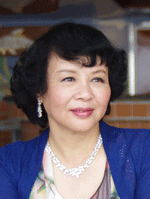Keynote Speakers
Personal Thermal Comfort System, A New Challenge to Building Energy Simulation
Yingxin Zhu, PhD, Professor, Tsinghua University, Beijing, China
In almost all building energy simulation tools such as DeST, EnergyPlus and ESPr, lumped parameter models are used for indoor environment description. The hypothesis is that the indoor environmental parameters are distributed in a space homogeneously, so that a single value of temperature or humidity can represent the thermal condition of the whole space. In conventional HVAC system design, the target is to control the thermal parameters of the whole space. Therefore, the lumped parameter model can reflect the indoor environment building energy accurately. In recent years, zonal model has been used for large space such as high atrium, gymnasium and so on, because usually the air parameters of the upper part are very different from the occupied bottom space. In this case, the large and high space will be divided in to several zones compartmented by fictitious partitions, and lumped parameter model is used for each zone.
In order to decrease heating/cooling demand while increasing satisfaction of indoor environment, personal thermal comfort system has been proposed in IEA-EBC Annex 69 (Strategy and Practice of Adaptive Thermal Comfort in Low Energy Buildings). In fact, an occupant only needs the surrounding environment to meet his thermal comfort demand rather than the whole space. Based on the theory of adaptive thermal comfort, comfort thermal environment can be varied even for a particular person, depending on his indoor/outdoor thermal experience, level of perceived control, physiological and psychological conditions of the time. It should be noticed that perceived control can improve thermal comfort significantly. Considering the diversity of thermal demand of occupants, personal comfort system (PCS) will be the final solution. PCSs include facilities such as personal ventilation, ambient-task air-conditioning, Japanese Kotatsu, cooling/heating chair in development, etc.
The cooling/heating load through the fabrics and outside air load usually depend on the ambient temperature, but it will be very different from that in the occupant¡¯s task zone if PCSs are used. How to simulate such kind of indoor environments? What value should be used as the representative value of the indoor parameters for the building spaces if the lumped parameter model still be used? How to compute the energy consumption of PCSs? It will become a new challenge to building simulation.

Dr. Yingxin Zhu is a professor and the vice-dean of School of Architecture, Tsinghua University, China. She is currently the Chair of the China National Steering Committee for HVAC Engineering Education, a fellow of IBPSA, and a fellow of ISIAQ Academy. She has worked for long on building and HVAC system simulation, and was a author of STESS, a subway thermal environment simulation system. Her current research focuses on adaptive thermal comfort and low energy buildings, for which building simulation is used as the important tool.
Effective Use of Simulation thorough Commissioning Process
Masaya Okumiya, Doctor of Eng., Professor, Nagoya University, Japan
Commissioning process is ¡°the process focuses upon verifying and documenting that all of the commissioned systems and assemblies are planned, designed, installed, tested operated, and maintained to meet the Owner¡¯s Project Requirements¡±1). If commissioning is carried out according to OPR of suitable and clear contents, the actual performance corresponding to a target can be realized. In the process verifying, documenting and also communication are very important.
It is necessary to set an appropriate performance index in commissioning process, and the quantitative indexes such as annual energy consumption are included. Then it is necessary to verify whether this quantitative performance index is filled in a design, construction, and an operation phase. For this purpose, simulation can be used effectively.
At first, the simulation is used to make boundary condition. For example, a load calculation corresponds to it. And, in the load calculation, an effect of the effect of the architectural energy saving method has to be reflected certainly.
At the completion of basic design and the detailed design, air conditioning or other simulation is used to confirm whether the quantitative indexes such as annual energy consumptions described in OPR are met.
During construction phase, the equipment delivered actually is selected. One of standards for selection is energy performance as the systems which was confirmed at the time of a design. And an energy consumption is calculated for confirmation by the simulation using the characteristic of the equipment which will be delivered.
comparison between real energy consumption and above mentioned calculated value is carried out. When there is disagreement, the factor is considered, and an influence degree of each factor is confirmed by simulation. Furthermore, the plan to improve the efficiency of the system is proposed, and it's applied to an actual system after the effect was verified by a simulation.
A process above-mentioned is explained including an example in keynote speech.
1) ASHRAE Standard 202-2013, Commissioning Process for Buildings and Systems

Masaya Okumiya is Professor of Graduate School of Engineering and Director of Campus Planning & Environmental Management Office (Advisor to the President) of Nagoya University, Japan. He is President of SHASEJ (Society of Heating, Air-conditioning, and Sanitary Engineers of Japan) and IBPSA-Japan. His major research fields are HVAC System, District Heating and Cooling System, Optimal Design and Control, Life Cycle Energy management, Commissioning and Renewable Energy.
Current Status of Desiccant-Assisted Air Conditioning Systems
Jae-Weon Jeong, Ph.D., Associate Professor, Hanyang University, Korea
Interest in non-vapor compression heating, ventilation, and air conditioning (HVAC) systems that do not use conventional refrigerants has increased over the last decade. Liquid desiccant (LD) and/or evaporative cooling-assisted systems can be categorized as non-vapor compression HVAC systems. Such systems can use a low-temperature heat source, improve indoor thermal comfort and air quality, and provide high energy-saving potential. An LD and evaporative cooling-assisted 100% outdoor air system (LD-IDECOAS) suggested in open literature is one such alternative system.
The LD-IDECOAS uses the evaporative latent heat of water to cool the supply air (SA), and enhances the evaporative cooling performance by dehumidifying the SA through the liquid LD unit. In addition, the LD-IDECOAS uses 100% outside air to maintain the target indoor thermal environment, and does not reintroduce the exhaust air (EA) into the SA side. The major components of an LD-IDECOAS are the LD unit, indirect evaporative cooler (IEC), and direct evaporative cooler (DEC). In hot and humid climate, the outdoor air is dehumidified by the LD unit, and then the IEC and DEC cool the dry SA to meet the target SA conditions. The dehumidification performance of the LD unit plays a significant role in enhancing both the cooling potential of the evaporative coolers and the operating energy savings. It was indicated that the LD-IDECOAS consumes significantly less operating energy during the cooling season than conventional VAV systems, if the LD-IDECOAS adopts water-side free cooling and renewable energy systems. In this keynote speech, more detailed information about the current status of desiccant-assisted evaporative cooling system will be provided.

Jae-Weon Jeong is an Associate Professor of Department of Architectural Engineering in Hanyang University, Korea. He is Treasurer of ASHRAE South Korea Chapter, and Member of ASHRAE and IBPSA-Korea. His major research fields are DOAS Systems, Desiccant-assisted Cooling, Evaporative Cooling Systems, Radiant Cooling and Heating, Renewable Energy Systems in Building Applications, and System Optimization and Controls.





